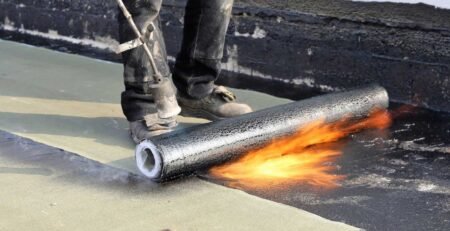The History of Bitumen: From Ancient Uses to Modern Applications
The history of Bitumen goes back to when ancient civilizations were ruling the world. However, there were other binding materials, such as natural asphalt, lime mortar, pozzolana, and clay; these civilizations used bitumen as the main material in waterproofing projects, road construction, and shipbuilding. Bitumen is extracted using several methods, yet the oil refining industry has developed this process, as bitumen had a great role in the 20th century’s construction projects. There are several types and grades of bitumen, and each one is suitable for specific project needs. Bitumen offers flexibility and waterproofing, which are critical factors for regions with harsh climates. Bitumen is widely used in the UAE for various construction applications, such as roadways, airports, and waterproofing. The UAE plays a critical role in supplying this material across the Middle East.
What Is Bitumen: Early History and Origins
According to Highways Today, The history of bitumen and bitumen origins goes back thousands of years. It is a semi-solid form of petroleum used in various ancient civilizations as it offered the required waterproofing and adhesive properties. In the history of bitumen, it is hard to name a single inventor; however, it is estimated that the first ancient uses of bitumen belong to ancient Mesopotamia. Other civilizations, such as the Greeks, Egyptians, Phoenicians, and Romans, also used bitumen for different purposes, such as waterproofing ships, road construction, embalming, and caulking. These ancient civilizations used other binding materials, such as:
- Natural Asphalt: Natural asphalt is very similar to bitumen. It is a black, sticky liquid or semi-solid material with a high viscosity, which is normally found in natural deposits.
- Lime Mortar: Lime mortar is a binding material containing lime, water, and sand. It is mainly produced by burning limestone. It was used for ancient masonry construction applications.
- Pozzolana: Pozzolana is a volcanic ash. The Romans used this natural material to create hydraulic cement. It hardened after being mixed with water, and the most important point is that this mixture could be set underwater.
- Clay: Clay was used in ancient pottery to build various materials. It was also used as a binder in primitive mortars.
Bitumen in Waterproofing
A main beneficial feature of bitumen in ancient uses was its waterproofing properties. For instance, the ancient Egyptians commonly used bitumen as a sealant in the mummification processes so it could preserve the bodies of their dead. Bitumen was also widely used to waterproof containers so they could hold water or liquids securely with no leakage. Lastly, in the history of bitumen, it was a popular protective coating for structures, such as temples or buildings, to prevent water damage.
Bitumen in Ship Building
Bitumen was a useful material in shipbuilding. Ancient civilizations, such as the Mesopotamians and Phoenicians, used it as a caulking material. When applied between the wooden planks, it would act as a watertight seal, helping prevent leakage and increasing the durability of the vessels. Seafaring civilizations required the help of this material, as it enabled them to build more secure and reliable ships for different purposes, such as exploration or trade.
Bitumen in Road Construction
In the history of bitumen, one of the earliest uses of this material in road construction was during the Babylonian era. They used bitumen in their roads to create a stable surface and a durable road. Romans also used this material for road construction, especially in their paved road network. It helped with constructing roads, enabling the efficient movement of troops, goods, and information.
The Development of Modern Bitumen
Although bitumen’s uses have evolved over time, it has remained popular due to its versatility, durability, and cost-effectiveness. As infrastructure development and maintenance needs grow globally, bitumen will most likely remain an important material in different industries and projects.
Bitumen Extraction and Refining Techniques
Bitumen extraction methods have changed over time. Modern bitumen extraction and production began in the late 19th century when the oil refining industry was developing. Fractional distillation is required to extract bitumen from crude oil.
- Crude oil is heated to separate various components.
- This separation is done based on their boiling points.
- Bitumen is the heaviest component; thus, it is obtained from the bottom of the distillation tower.
- Air-blowing or blending with other components will help modify the properties of the bitumen.
- The extracted bitumen will be used for specific applications with specific requirements.
Bitumen’s Role in 20th Century
Bitumen played a critical role in the construction boom of the 20th century and was a key part of road infrastructure in this century.
- In the history of bitumen, its mixture with aggregates, creating the modern asphalt, was a revolution in road construction.
- Modern asphalt has helped improve extensive highway networks. This led to huge economic growth in many countries.
- It also had a great role in improving transportation by increasing the connectivity between rural and urban areas.
- In addition to road construction, bitumen was widely used in the roofing industry as well.
- Bitumen’s perfect waterproofing properties made it a popular choice for roof construction in the 20th century.
- Bitumen helped in protecting buildings from water damage.
- This feature also helped with improving the durability of the constructed roofs.
Types and Properties of Bitumen
Referring to ThoughtCo, Bitumen is a commonly used material in the construction industry. It offers several different grades and forms to meet specific needs in various projects. Bitumen’s specific properties, such as flexibility and waterproofing, make it a good choice for applications in harsh climates like the Middle East. Understanding the various forms of bitumen and its unique properties is a great help in selecting the most suitable material for each project and application.
Introduction to Various Grades and Forms
- Penetration Grade: The grading system based on penetration classifies bitumen according to its hardness. This classification is commonly used for road construction. The grades in this system are 40/50, 60/70, and 80/100.
- Blown Bitumen: Blown bitumen, also known as oxidized bitumen, is produced by blowing air into the material. This procedure leads to higher softening points and increases the hardness. Some of these grades are 115/15 and 150/5.
- Bitumen Emulsions: Bitumen emulsions are dispersions of bitumen in water stabilized by emulsifiers. They are mainly used for tack coating, surface dressing, and cold-mix asphalt.
Essential Properties for Harsh Middle Eastern Climates
- Flexibility: Temperature fluctuation normally induces stress. Bitumen withstands this stress excellently. Softer grades, such as 80/100, show the required flexibility in road construction projects and their maintenance in such conditions.
- Waterproofing: in the history of bitumen, it has always been a popular choice due to its waterproofing. It has excellent waterproofing properties that make it a critical choice for roof construction since it can protect the building from water damage. Bitumen is an excellent choice for both hot and rainy seasons.
Bitumen’s Rise in the UAE and the Middle East
Bitumen plays an essential role in the development of UAE infrastructure. Its specific properties make it an ideal choice for many projects and applications. In transportation and waterproofing areas, Bitumen is a critical component. The country’s strategic role in supplying this material across the Middle East is significant.
Significance of Bitumen in the UAE
Bitumen plays a significant role in the development of UAE infrastructure. It is a critical material in constructing roadways, airports, and waterproofing applications. This material withstands the harsh climate of regions like the UAE. It also bears heavy traffic loads, making it a popular and essential component in many projects in this country.
Roadways
Bitumen grades with higher qualities, such as 60/70 and 80/100, are massively used in the construction and maintenance of the road network in the UAE, such as highways, local streets, and even bridges. Bitumen offers a durable and reliable performance for the UAE’s harsh climate and heavy traffic.
Airports
Bitumen is critical in the UAE’s aviation sector, as it is essential for constructing and maintaining runways, taxiways, and aprons. It is a highly resistant material to fuel and chemical spills and has a high load-bearing capacity. It also has weatherproofing characteristics, which is a critical reason for its application in airport infrastructure projects.
Waterproofing
Bitumen’s waterproofing properties manage many construction applications, such as roofing, underground structures, and basement waterproofing. The UAE has an arid climate with heavy rainfall, which is why this material is widely used for various applications.
UAE’s Strategic Location in Bitumen Supply
The UAE is located in the bitumen supply chain and has developed its infrastructure for this purpose. The UAE supplies the Middle East’s needs for bitumen, which has led to significant economic growth in the country.
Final Thoughts
Because of its unique specifications and properties, bitumen has been widely used for various applications. Nowadays, it plays a critical role in construction projects and their maintenance. The right choice of bitumen grade will ensure reliable and durable performance in all applications of this material.












Leave a Reply